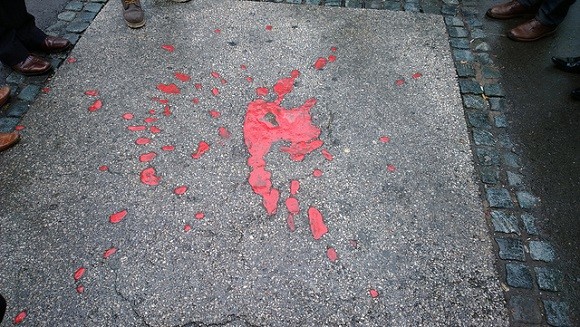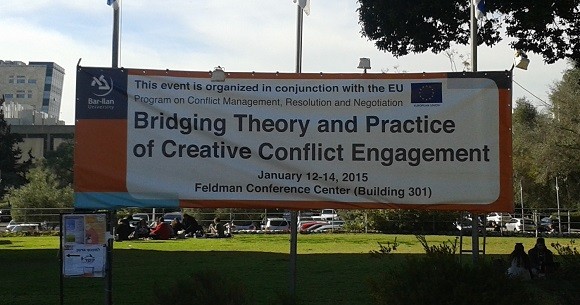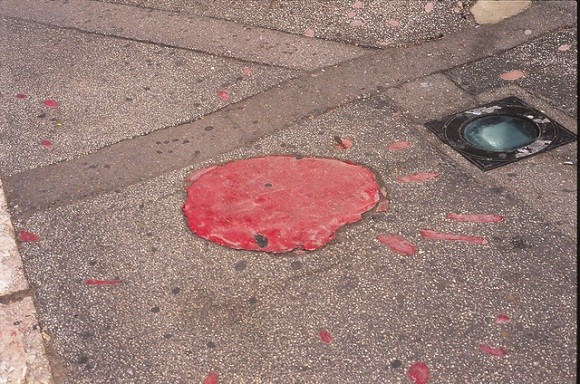 ‘Sarajevo Roses’ are spread throughout the Bosnian capital. These scars from exploded shells have been filled with resin as a memorial to the victims of the conflict. Image credit: Alex Ross Shaw.
‘Sarajevo Roses’ are spread throughout the Bosnian capital. These scars from exploded shells have been filled with resin as a memorial to the victims of the conflict. Image credit: Alex Ross Shaw.In January, a key international conference for peacebuilders was held at the Bar-Ilan University in Israel. The focus of the conference was on how to bridge the gap between theory and practice in conflict management: to engage with new methods of conflict resolution, to find the best way to transform and manage conflicts, and ultimately to prevent the horror of war.
The next generation will always be key to resolving conflict. As such, the opening panel of the conference discussed how to personally engage students in teaching and learning about the past.
Taking part in the panel, I highlighted the role of storytelling and narrative in education. This is one way of approaching the difficulties of dealing with history. The panel also discussed the importance of stories and how they can be used as a tool in teaching peace and conflict studies. I talked about my own experience of using stories in the classroom, discussing lessons based on the culture of remembrance.
Culture and remembrance: vital to the past - and crucial for the future
Specifically, I talked about the ‘MemorInmotion’ teaching tool. This focuses on the role of remembrance in culture, which has been discussed by other peace and conflict researchers.
When young people are engaged with history, they can share perspectives and create new perspectives on the past. They can critically reflect on public cultures of remembrance, which in turn increases their awareness of the role and responsibility of memorialisation. By promoting reflection on the past - and different possible futures - it helps to establish trust between individuals and communities from different backgrounds, to restore dialogue and rebuild peaceful relationships.
 The conference brought together key academics and policymakers to discuss issues in conflict management. Image credit: Nerkez Opacin.
The conference brought together key academics and policymakers to discuss issues in conflict management. Image credit: Nerkez Opacin.Memory in peacebuilding: remembering the Bosnian war through Sarajevo Roses
Memorialisation can be a powerful tool in peace education and peacebuilding. It enables people to explore different ways to deal with difficult wartime memories, to challenge dominant historical narratives, and to question conventional concepts of identity. In my personal teaching history, I have shown groups of Bosnian students a film entitled Sarajevo Roses, and been amazed by their feedback.
Sarajevo Rose is the name given to the pattern created when a mortar shell exploded on concrete. As a memorial to those killed during the siege of Sarajevo, many of these explosion scars have been filled with red resin.
Getting students to talk freely and openly about their feelings about such ideas helps them to discuss not just memorialisation, but the peace and conflict processes which make memorialisation necessary.
 Image credit: Reuben Thompson
Image credit: Reuben ThompsonIndeed, by evoking a greater understanding of the ‘Other’ – the opposing side in a particular conflict – storytelling can be a powerful peacebuilding tool. And stories also have another purpose: moral pressure. Stories can be about hope – about what should be – and can therefore work towards shaping processes and ideas that bring about change.
Storytellers focus on the past in order to comment upon problems, needs and desires that exist in the present. Stories are therefore fundamental to the future: they unite children and adults, the past, present and future, across cultures.
This is why stories play an important role in peace education, and empowering young people to become peacemakers themselves. If they hear stories of people from other inter-communal conflicts, they can realise how people on both sides of the conflict have suffered, and thus become motivated to work for change and peace. Stories are fundamental to history - and fundamental to peace.









